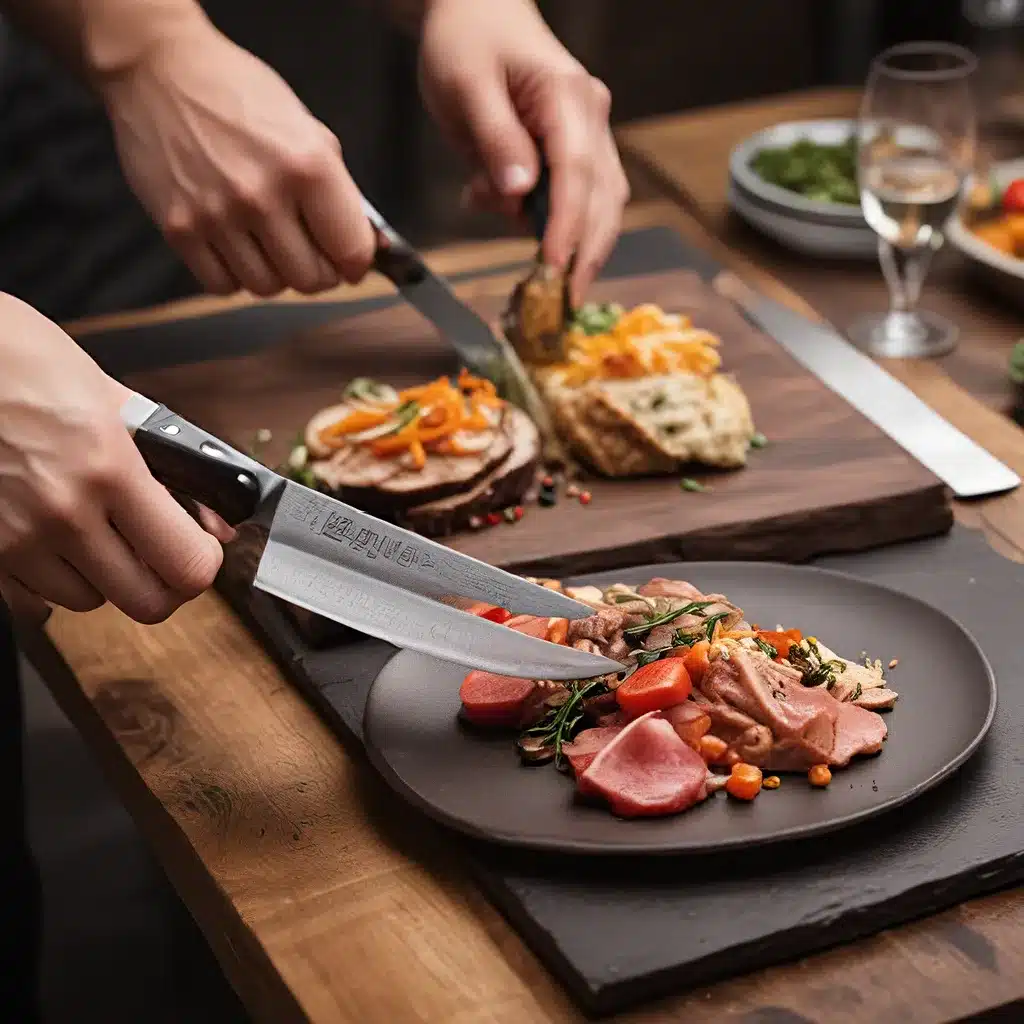
As a passionate home chef, I’ve always been fascinated by the art of food presentation. It’s not just about the taste – it’s about creating a truly memorable dining experience that engages all the senses. And when it comes to knife skills, I’ve learned that they’re not just for chopping and slicing; they’re an integral part of the plating process that can elevate a dish from ordinary to extraordinary.
Mastering the Fundamentals: Knife Techniques for Flawless Food Presentation
One of the most important aspects of knife skills for food presentation is precision. Chefs labor over their food for countless hours to create a moment of pleasure for their guests, and the final plate presentation is the culmination of all that hard work. That’s why mastering techniques like clean, uniform cuts and delicate garnishing is so crucial.
I remember the first time I tried my hand at plating a fancy dish – it was a filet mignon with a potato puree, roasted carrots, and a drizzle of demi-glace. I thought I had it all figured out, but when the plate came out of the kitchen, it looked like a hot mess. The carrots were unevenly sliced, the puree was haphazardly smeared, and the demi-glace had pooled in the center, creating a sad little puddle.
It was a humbling experience, but it taught me an important lesson: Food plating is an art form, and the knife is the artist’s most essential tool. I dove headfirst into learning proper knife techniques, practicing my cuts on everything from vegetables to proteins until I could create paper-thin slices and perfectly diced cubes in my sleep.
Elevating the Plate: Leveraging Knife Skills for Visually Stunning Presentations
Once I had the basics down, I started experimenting with more advanced plating techniques. Sauces became my canvas, and I learned how to use a squeeze bottle or a spoon to create intricate patterns and sweeping brushstrokes. Garnishes became more than just an afterthought – I carefully selected herbs, edible flowers, and crispy elements to add pops of color and textural contrast.
But the true game-changer was learning how to leverage my knife skills to create visually stunning presentations. Precisely sliced proteins, elegantly fanned vegetables, and artfully arranged components all work together to draw the eye and tantalize the senses. It’s like a culinary version of the rule of thirds, with the focal point of the dish anchoring the composition and the supporting elements adding depth and balance.
Embracing the Japanese Influence: Lessons from the Masters of Plate Presentation
As I continued to hone my plating skills, I couldn’t help but be inspired by the Japanese culinary traditions, particularly the Kaiseki style of dining. The emphasis on seasonality, balance, and attention to detail resonated with me, and I found myself incorporating more and more of these concepts into my own work.
One of the key lessons I’ve learned from Kaiseki is the importance of negative space. Rather than cramming the plate with a jumble of ingredients, the Japanese chefs understand the power of leaving room for the eye to rest. They use height, asymmetry, and gentle curves to create a sense of harmony and visual interest, all while highlighting the natural beauty of the individual components.
Embracing the Unexpected: Deconstructed Dishes and Free-Form Plating
Of course, as much as I appreciate the elegance of traditional plating techniques, I’m always eager to push the boundaries and try something new. That’s where deconstructed dishes and free-form plating come into play.
With deconstructed dishes, the goal is to reimagine a classic dish in a way that challenges the diner’s expectations. Instead of a neatly assembled plate, the components are presented separately, inviting the guest to explore the flavors and textures in a more interactive way. It’s a playful approach that allows me to showcase my knife skills in a more creative, artful manner.
And when it comes to free-form plating, I love the sense of organized randomness that it brings to the table. By eschewing the rigid structure of traditional plating, I can create a more organic, intuitive presentation that still adheres to the principles of visual balance and harmony. It’s a style that lends itself particularly well to sharing plates and tasting menus, allowing me to showcase a wider range of flavors and techniques in a visually captivating way.
The Versatile Knife: Your Key to Unlocking Culinary Artistry
At the end of the day, the knife is the most versatile and essential tool in my culinary arsenal. Whether I’m meticulously slicing a piece of sashimi or boldly deconstructing a classic dish, my knife skills are the foundation upon which I build my culinary creations.
And the best part? These techniques aren’t just for professional chefs – they’re accessible to home cooks like myself who are passionate about elevating the dining experience. By investing in a high-quality knife and practicing your cuts and slices, you can unlock a whole new world of plate presentation possibilities.
So the next time you’re plating up a meal, don’t just think about the flavors – think about the visual story you’re telling. Use your knife to create clean lines, elegant shapes, and captivating compositions that will leave your guests in awe. After all, the true art of dining is in the presentation, and the knife is the tool that can make that magic happen.


